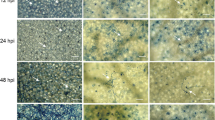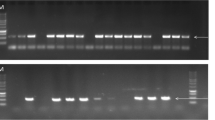Abstract
Air-borne spores of the Fusarium head blight (FHB) pathogenwere trapped at field sites in both Australia and the USA using susceptible wheat plants to establish whether ascospores or conidia were the dominant FHB inoculum. Although both ascospores and conidia were recovered from flowering spikes during a 28-day period between anthesis and grain filling, ascospores were the dominant spore type at Fargo, North Dakota in the USA. Conversely in Australia, conidia were the dominant spore type trapped during 16 and 21-day periods of sampling over 2 years at two sites in northern New South Wales. The effectiveness of Gibberella zeae ascospores and conidia as inoculum for FHB and crown rot (CR)was compared in plant infection assays using 10 isolates each from the USA and Australia. Overall, ascospores were less effective in causing FHB and CR than conidia, although the difference in FHB severity between the two spore types was small. Ascospores of isolates from the USA caused significantly less severe CR on three North American cultivars and some isolates with highly aggressive conidial inoculum were weakly aggressive with ascosporic inoculum. In contrast, both spore types of the Australian isolates caused severe CR and there was no significant difference between the spore types for CR severity on three North American cultivars. Studies such as these on pathogen biology and epidemiology are essential to examine whether the information gained in one geographical location can be effectively used to manage the pathogen in another location.
Similar content being viewed by others
References
Akinsanmi OA (2004) Etiology and diversity of Fusarium species causing head blight of wheat in Australia. PhD thesis, University of Queensland, Brisbane.
Akinsanmi OA, Mitter V, Simpfendorfer S, Backhouse D, Chakraborty S (2004) Identity and pathogenicity of Fusarium spp. isolated from wheat fields in Queensland and northern New South Wales. Australian Journal of Agricultural Research 55, 97–107. doi: 10.1071/AR03090
Akinsanmi OA, Backhouse D, Simpfendorfer S, Chakraborty S (2006) Genetic diversity of Australian Fusarium graminearum and F. pseudograminearum. Plant Pathology, In press. doi: 10.1111/j.1365-3059.2006.01398.x
Anderson AL (1948) The development of Gibberella zeae head blight of wheat. Phytopathology 38, 599–611.
Aoki T, O’Donnell K (1999) Morphological and molecular characterization of Fusarium pseudograminearum sp nov., formerly recognized as the Group 1 population of F. graminearum. Mycologia 91, 597–609.
Backhouse D, Abubakar AA, Burgess LW, Dennis JI, Hollaway GJ, et al. (2004) Survey of Fusarium species associated with crown rot of wheat and barley in eastern Australia. Australasian Plant Pathology 33, 255–261. doi: 10.1071/AP04010
Bai GH, Shaner G (1994) Scab of wheat: prospects for control. Plant Disease 78, 760–766.
Ban T (1997) Evaluation of resistance to fusarium head blight in indegenous Japanese species of Agropyron (Elymus). Euphytica 97, 39–44. doi: 10.1023/A:1003078109694
Bateman GL (2005) The contribution of ground-level inoculum of Fusarium culmorum to ear blight of winter wheat. Plant Pathology 54, 299–307. doi: 10.1111/j.1365-3059.2005.01181.x
Brennan JP, Murray GM (1998) ‘Economic importance of wheat diseases in Australia.’ (NSW Agriculture: Wagga Wagga)
Brown DW, Desjardins AE, Yun S-H, Plattner R, Lee T (2001) Are Gibberella zeae sexual spores the critical inoculum leading to FHB epidemics? In ‘2001 National Fusarium Head Blight Forum Proceedings. Dec. 8–10, 2001’. p. 104. (US Wheat and Barley Scab Initiative: Erlanger). Available at http://www.scabusa. org/forum.html (verified 14 June 2006)
Burgess LW, Wearing AH, Toussoun TA (1975) Survey of Fusaria associated with crown rot of wheat in eastern Australia. Australian Journal of Agricultural Research 26, 791–799. doi: 10.1071/AR9750791
Burgess LW, Dodman R, Mayers P, Pont W (1981) Fusarium diseases of wheat, maize and grain sorghum in eastern Australia. In ‘Fusarium: diseases, biology and taxonomy’. (Eds P Nelson, T Toussoun, R Cook) pp. 64–76. (Pennsylvania State University Press: University Park)
Burgess LW, Klein TA, Bryden WL, Tobin NF (1987) Head blight of wheat caused by Fusarium graminearum Group 1 in New South Wales in 1983. Australasian Plant Pathology 16, 72–78. doi: 10.1071/APP9870072
Burgess LW, Backhouse D, Summerell BA, Swan LJ (2001) Crown rot of wheat. In ‘Fusarium: Paul E. Nelson Memorial Symposium’. (Eds BA Summerell, JF Leslie, D Backhouse, WL Bryden, LW Burgess) pp. 271–294. (APS Press: St Paul)
Busch R (1995) Breeding for scab resistance. In ‘Proceedings 1994 Regional Scab Forum Research. Conference’. p. 3. (Minnesota Wheat Research and Promotion Council: Red Lake Falls)
Cook RJ (1981) Fusarium diseases of wheat, maize and other small grains in North America. In ‘Fusarium: diseases, biology and taxonomy’. (Eds PE Nelson, TA Toussoun, RJ Cook) pp. 39–52. (Pennsylvania State University Press: University Park)
De Luna L, Bujold I, Carisse O, Paulitz TC (2003) Ascospore gradients of Gibberella zeae from overwintered inoculum in wheat fields. Canadian Journal of Plant Pathology 24, 457–464.
Fernandez MR, Pearse P, Holzgang G, Hughes G (2000) Fusarium head blight in common and durum wheat in Saskatchewan in 1999. Canadian Plant Disease Survey 80, 57–59.
Fernando WGD, Paulitz TC, Seaman WL, Dutilleul P, Miller JD (1997) Head blight gradients caused by Gibberella zeae from area sources of inoculum in wheat field plots. Phytopathology 87, 414–421.
Francis RG, Burgess LW (1977) Characterization of two populations of Fusarium roseum ‘Graminearum’ in eastern Australia. Transactions of the British Mycological Society 68, 421–427.
Francl L, Shaner G, Bergstrom G, Gilbert J, Pedersen W, et al. (1999) Daily inoculum levels of Gibberella zeae on wheat spikes. Plant Disease 83, 662–666.
Francl LJ, Larson C, De Wolf ED (2000) Description and evaluation of the NDSU regional wheat disease forecasting system. In ‘2001 National Fusarium Head Blight Forum Proceedings. Dec. 8–10, 2001’. (US Wheat and Barley Scab Initiative: Erlanger). Available at http://www.scabusa.org/forum.html (verified 14 June 2006)
Hill JP, Fernandez J, McShane MS (1983) Fungi associated with common root rot of winter wheat in Colorado and Wyoming. Plant Disease 67, 795–796.
Hörberg HM (2002) Patterns of splash dispersed conidia of Fusarium poae and Fusarium culmorum. European Journal of Plant Pathology 108, 73–80. doi: 10.1023/A:1013936624884
Inglis DA, Malloy OC (1983) Scab caused by Gibberella zeae occurring on irrigated wheat in Eastern Washington. Plant Disease 67, 827–828.
Klein TA, Burgess LW, Ellison FW (1991) The influence and spatial patterns of wheat plants infected by Fusarium graminearum Group 1 and the effect of crown rot on yield. Australian Journal of Agricultural Research 42, 399–407. doi: 10.1071/AR9910399
McMullen M, Jones R, Gallenberg D (1997) Scab of wheat and barley: A re-emerging disease of devastating impact. Plant Disease 81, 1340–1348.
Maldonado-Ramirez SL, Bergstrom GC (2000) Temporal patterns of ascospore discharge by Gibberella zeae from colonized corn stalks under natural conditions. In ‘2001 National Fusarium Head Blight Forum Proceedings. Dec. 8—10, 2001’. pp. 159–162. (US Wheat and Barley Scab Initiative: Erlanger). Available at http://www.scabusa.org/forum.html (verified 14 June 2006)
Marasas WFO, Voigt WGJ, Lamprecht SC, Van Wyk PS (1988) Crown rot and head blight of wheat caused by Fusarium graminearum Groups 1 and 2 in the southern Cape province. Phytophylactica 20, 385–389.
Markell SG, Francl LJ (2003) Fusarium head blight inoculum: species prevalence and Gibberella zeae spore type. Plant Disease 87, 814–820.
Miedaner T, Schilling AG (1996) Genetic variation of aggressiveness in individual field population of Fusarium graminearum and Fusarium culmorum tested on young plants of winter rye. European Journal of Plant Pathology 102, 823–830. doi: 10.1007/BF01877051
Nicholson P, Simpson D, Weston G, Rezanoor HN, Lees AK, et al. (1998) Detection and quantification of Fusarium culmorum and Fusarium graminearum in cereals using PCR assays. Physiological and Molecular Plant Pathology 53, 17–37. doi: 10.1006/ pmpp.1998.0170
Parry DW, Jenkinson P, McLeod L (1995) Fusarium ear blight (scab) in small grain cereals- a review. Plant Pathology 44, 207–238.
Paul PA, El-Allaf SM, Lipps PE, Madden LV (2004) Rain splash dispersal of Gibberella zeae within wheat canopies in Ohio. Phytopathology 94, 1342–1349.
Paulitz TC (1996) Diurnal release of ascospores by Gibberella zeae in inoculated wheat plots. Plant Disease 80, 674–678.
Paulitz TC, Smiley RW, Cook RJ (2002) Insights into the prevalence and management of soilborne cereal diseases under direct seeding in the Pacific Northwest, U.S.A. Canadian Journal of Plant Pathology 24, 416–428.
Purss GS (1971) Pathogenic specialization in Fusarium graminearum. Australian Journal of Agricultural Research 22, 553–561. doi: 10.1071/AR9710553
Scholz U, Steffenson BJ (2001) Effect of Gibberella zeae ascospores and Fusarium graminearum conidia on Fusarium head blight severity and deoxynivalenol production in barley. In ‘2001 National Fusarium Head Blight Forum Proceedings. Dec. 8–10, 2001’. pp. 147–149. (US Wheat and Barley Scab Initiative: Erlanger). Available at http://www.scabusa.org/forum.html (verified 14 June 2006)
Smiley RW, Patterson LM (1996) Pathogenic fungi associated with Fusarium foot rot of winter wheat in semiarid Pacific Northwest USA. Plant Disease 80, 944–949.
Smiley RW, Gourlie JA, Easley SA, Patterson L-M, Whittaker RG (2005) Crop damage estimates for crown rot of wheat and barley in the Pacific Northwest. Plant Disease 89, 595–604.
Southwell RJ, Moore KJ, Manning W, Hayman PT (2003) An outbreak of Fusarium head blight of durum wheat on the Liverpool Plains in northern New South Wales in 1999. Australasian Plant Pathology 32, 465–471. doi: 10.1071/AP03061
Specht LP, Rush CM (1988) Fungi associated with root and foot rot of winter wheat and populations of Cochliobolus sativus in the Texas panhandle. Plant Disease 72, 959–963.
Stack RW (1989) A comparison of the inoculum potential of ascospores and conidia of Gibberella zeae. Canadian Journal of Plant Pathology 11, 137–142.
Steel RGD, Torrie JH (1981) ‘Principles and procedures of statistics.’ (McGraw-Hill Book Company: Singapore)
Summerell BA, Burgess LW, Backhouse D, Bullock S, Swan LJ (2001) Natural occurrence of perithecia of Gibberella coronicola on wheat plants with crown rot in Australia. Australasian Plant Pathology 30, 353–356. doi: 10.1071/AP01045
Sutton JC (1982) Epidemiology of wheat head blight and maize ear rot caused by Fusarium graminearum. Canadian Journal of Plant Pathology 4, 195–209.
Tschanz AT, Horst RK, Nelson PE (1975) A substrate for uniform production of perithecia in Gibberella zeae. Mycologia 67, 1101–1108.
Williams KJ, Dennis JI, Smyl C, Wallwork H (2002) The application of species-specific assays based on the polymerase chain reaction to analyse Fusarium crown rot of durum wheat. Australasian Plant Pathology 31, 119–129. doi: 10.1071/AP01079
Author information
Authors and Affiliations
Corresponding author
Rights and permissions
About this article
Cite this article
Mitter, V., Francl, L.J., Ali, S. et al. Ascosporic and conidial inoculum of Gibberella zeae play different roles in Fusarium head blight and crown rot of wheat in Australia and the USA. Australasian Plant Pathology 35, 441–452 (2006). https://doi.org/10.1071/AP06046
Received:
Accepted:
Issue Date:
DOI: https://doi.org/10.1071/AP06046




